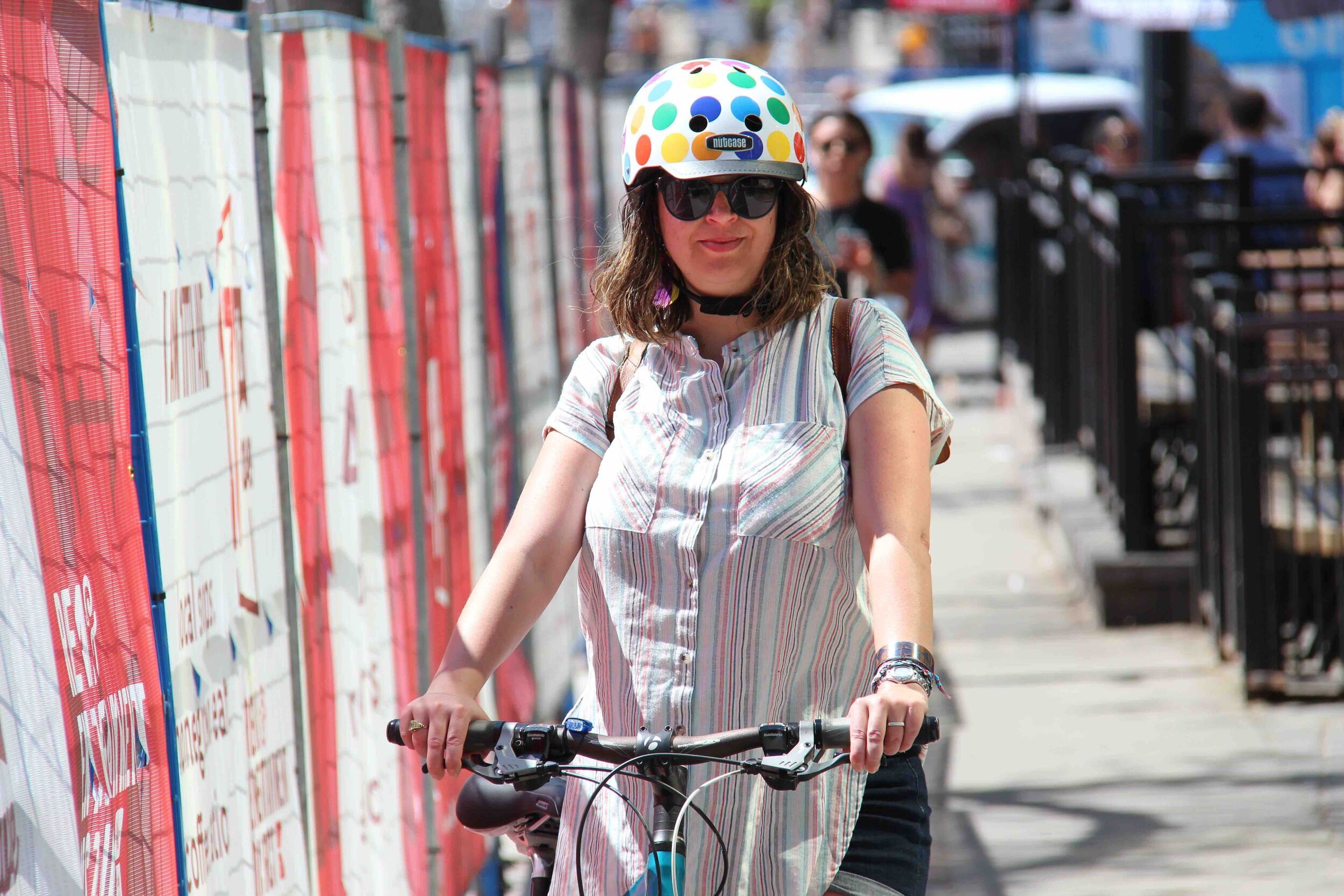
Calgary accidentally makes people-centric 17th Ave
Maybe this should tell us something.
This story is part of the Sprawl’s fourth pop-up edition, which is all about 17 Avenue SW and SE. Both of these streets are culturally, socially and economically significant to Calgary — and both are undergoing major construction, shaped by different visions.
We rely on crowdfunding to do what we do. Please support the Sprawl so we can keep doing in-depth local Calgary journalism like this!
Ximena González soaks up the sun on the Ship & Anchor patio, a golden pint of Village Barnacle pilsner in hand. A few metres away, 17th Avenue is ripped out and fenced off, closed to vehicle traffic.
The City of Calgary has warned her, warned all of us: construction this summer will be a doozy and, in the city’s parlance, “17th Ave is gonna be sweet” afterward. But González and other patio-going Calgarians have made a surprising discovery in recent days: a car-free 17th is already pretty sweet.
Maybe even sweeter than usual.
“I think I prefer this,” says González as a water truck roars by in the construction zone, then is gone. González runs a boutique PR agency that specializes in architecture and design, and in summertime bikes from her home in Sunnyside to 17th almost daily.
“It’s just nice,” she says. “I come to the Ship, I go to Beano, Analog—business meetings, too. One of my clients works on 4th Street, so we usually meet along here.”
While construction at times makes patio conversation on 17th difficult, the lack of loud motorcycles, cars and trucks are a welcome relief. And the new setup is starting to catch on.
It’s no pedestrian paradise by any means, with fences and little detours all over the place. But the heavy construction has changed the dynamic of the street—in good ways and bad—sparking a lively conversation about what’s possible on 17th.
“It’s a really cool conversation to have,” says Kate Mitchell, who manages events and marketing for Añejo Group, which has two restaurants on 17th (Blanco Cantina and the Living Room). “We haven’t noticed a dent in business. Chatting with some of our neighbours, some people have.”

“Really, I think people are preferring it, to be honest. You don’t have to dive through traffic. There’s still a struggle to find parking, but once you reach your destination and enjoy being on a patio or walking around, it really isn’t so bad.”
Mitchell thinks the city should explore ways to make 17th more people-friendly—up to and including closing the street to cars at times. Events like last weekend’s Red Mile Cup, a street hockey tournament, have a positive business impact, she says.
“We would love that, and I really think our customers and visitors to 17 Ave would be all over it,” says Mitchell. “Maybe not fully pedestrianized, but similar to Stephen Avenue where it’s closed to cars at certain times of the day.”
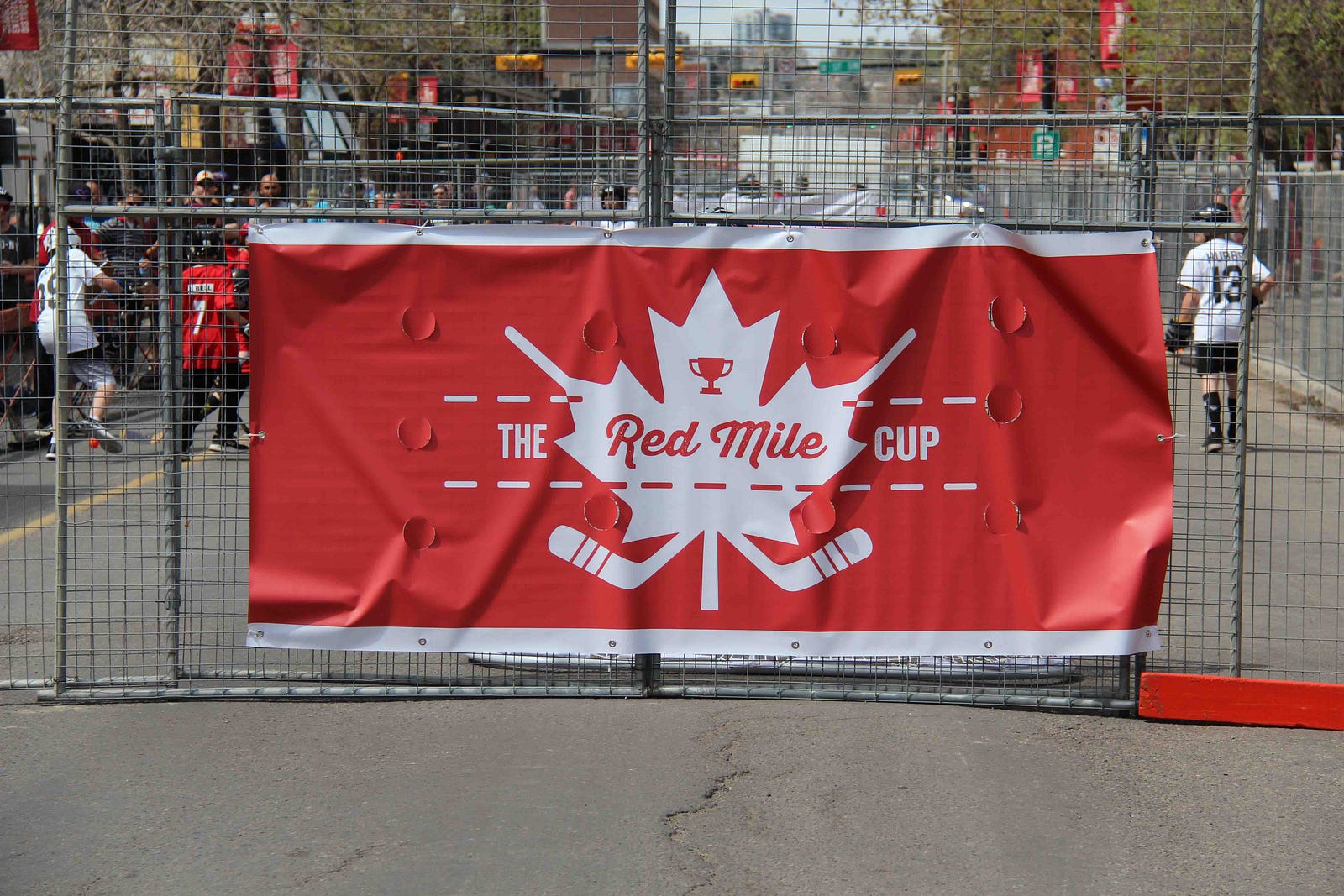
“This would be the chunk that I would do for sure: between 5th and 8th Streets, or even 6th and 8th.”
“You’re more likely to stop and have a look at a menu or read a sign when you’re walking than when you’re in a car.” — Kate Mitchell, Blanco Cantina
This perspective, needless to say, is not universally held on 17th. Across the street, at the Trolley 5 brewpub, owner Ernie Tsu is happy that loud motorbikes aren’t parking out front and disturbing patrons on his patio. But he believes the street works best as is—with its all-day mix of cars, bikes and pedestrians.
“We’ve taken a drop in business for sure [from construction], because you don’t have that vibrant street traffic,” he says.
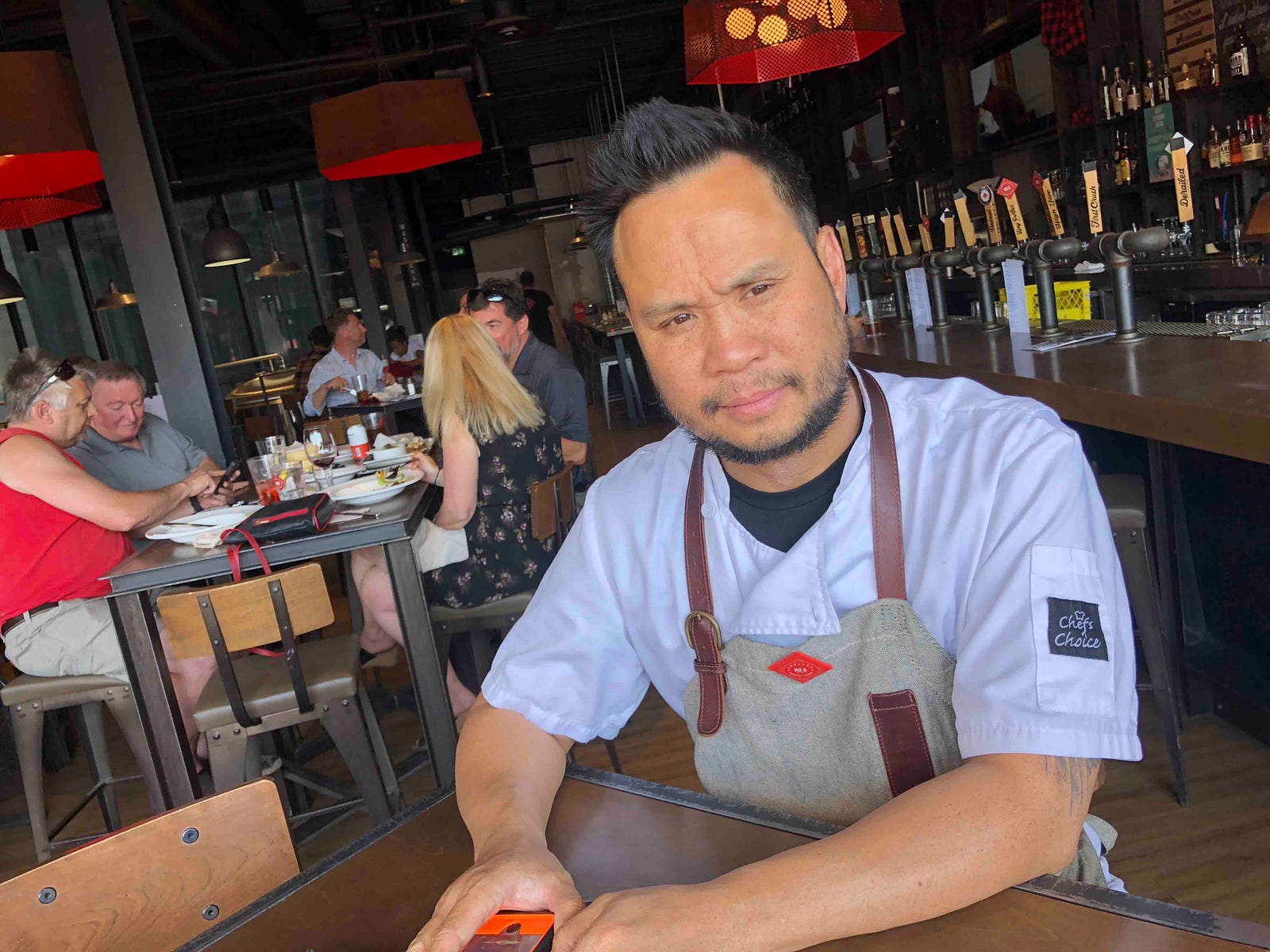
He’s less keen on exploring car-free times.
“It’s not just about us restaurants, it’s about the retail outlets too,” says Tsu. “You’d have to get consensus from all the businesses on that. From our standpoint here at Trolley 5, the traffic works better for us — the street open as usual. Just the vibrancy of 17 Avenue.”
“I wouldn’t want to lose the feel of what 17th Avenue is.”
‘Things really organically grow’
Tsu’s words—”the feel of what 17th Avenue is”—get at a larger question regarding the street’s future. Should the city have an ambitious plan for 17th, or stay out of the way and let it evolve, keeping its distinct, if imperfect, flavour?
“You have a very vibrant pedestrian kind of district, but it’s almost just sort of happened naturally over the years,” says Jeff Binks with the Red Mile Complete Street Advocacy Group. “What you see from other cities is direction from city council, city administration, where they’ve decided this street is going to be our one great street. And they put an overwhelming vision forward.”
Binks’s group is calling for such a vision, including a cycle track along 17th and more off-street parking options in the area. “I think 17th Ave has unfortunately suffered from a lack of a controlling vision for what the district should or could be,” says Binks.

But is an overarching master plan, driven by the city, the best route?
“I actually think what works about 17th is the lack of planning, to an extent,” says González. “It’s not like, ‘Okay, we’re going to have a street and it’s going to do this.’ It’s more like it organically becomes what it is now — and that gives it a lot of character.”
González notes that in Mexico, where she grew up, some of the best main streets just happen—they are not necessarily planned.
“Things really organically grow,” she says. “That brings a lot to the community, because it means that’s what people want. An area suddenly becomes a main street.”
“There’s a saying in Spanish: if you’re a hammer, everything looks like a nail. I feel like when you’re a planner and you see something that wasn’t planned, you think something went wrong. But planners don’t have as much power as they think.”
“As much as they make something very pretty and make renderings with people, things might not work out.”
Councillor Evan Woolley takes a similar view, noting that while there’s no master plan for 17th per se, the street is included in an overlapping hodgepodge of plans—including the area redevelopment plans of neighbouring communities.
“Maybe that’s why it’s been successful,” says Woolley of 17th. “I oftentimes think that if we make good decisions over decades, we don’t always need to be driven by a master plan of sorts. And in fact, what we often do as a city is we make a lot of great master plans, and by the time we get the money to do them or it comes iteratively, we end up with something quite different anyway.”
A 17th Ave cycle track?
There is one area where González believes the city should play a bigger role: bike infrastructure on 17th.
“You do need to plan that,” she says. “When they first started [construction] on the east side, I was like, ‘Oh my god, they’re going to have bike lanes!’”
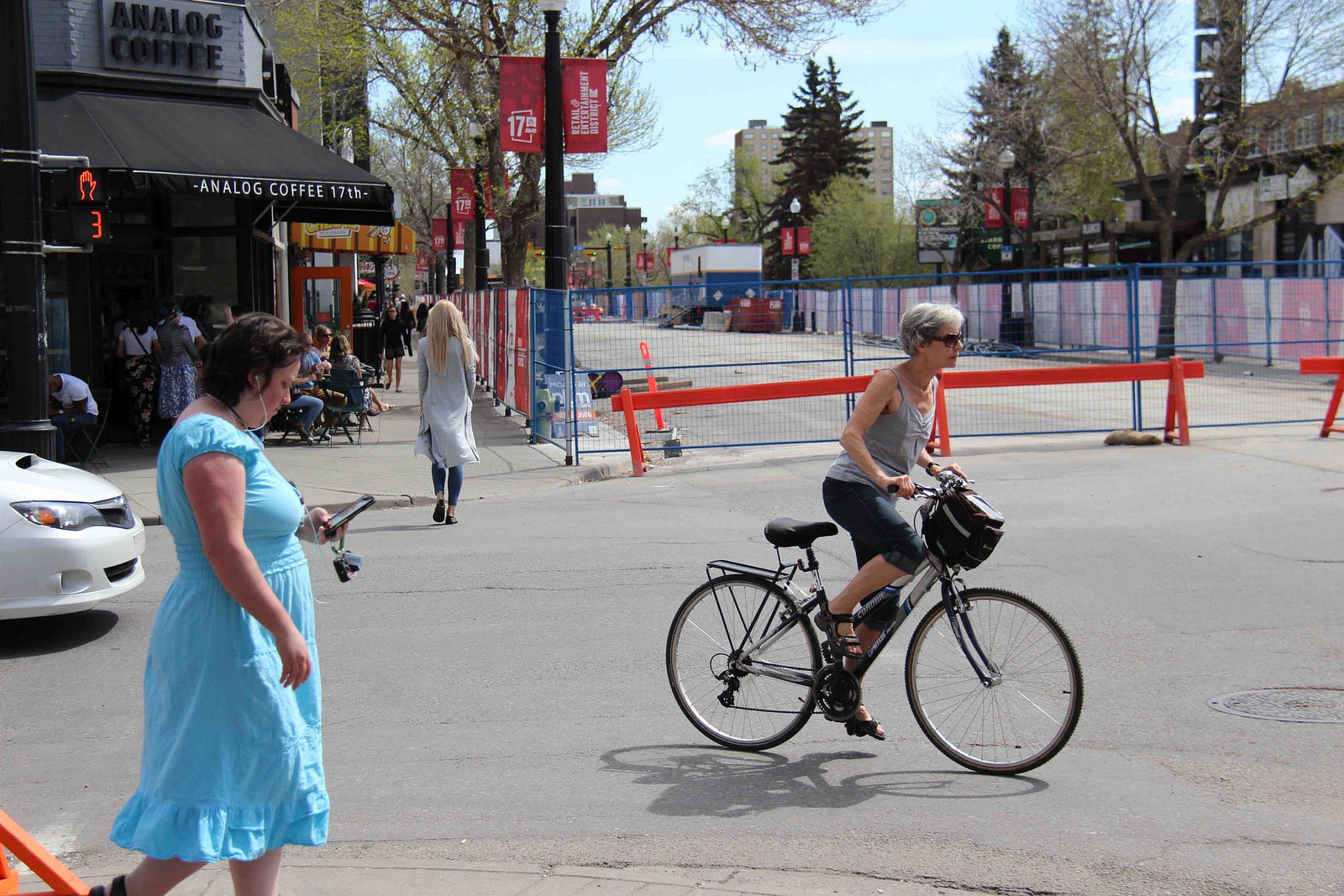
Her enthusiasm was short-lived. The city has balked at putting bike infrastructure on 17th, preferring to preserve on-street parking and keep the street as an east-west thoroughfare for vehicles. Instead, a painted bike lane is on 15th.
“They could get rid of one lane of parking and give us a little.” —Ximena González
“One of the great things about this kind of a corridor is all of the things that happen on it,” says Rollin Stanley, the city’s general manager of urban strategy. “And you actually want the cars parking there. People like to be able to park near where they’re going. And plus… when people have cars on one side, they feel protected from what’s happening in the street. They feel more secure in the evenings.”
“Do we need bike lanes on 17th? No. I’d put them on 16th or 19th. I ride my bike through here all the time. I don’t live that far from here. I’ll ride over to MEC. I love it.”
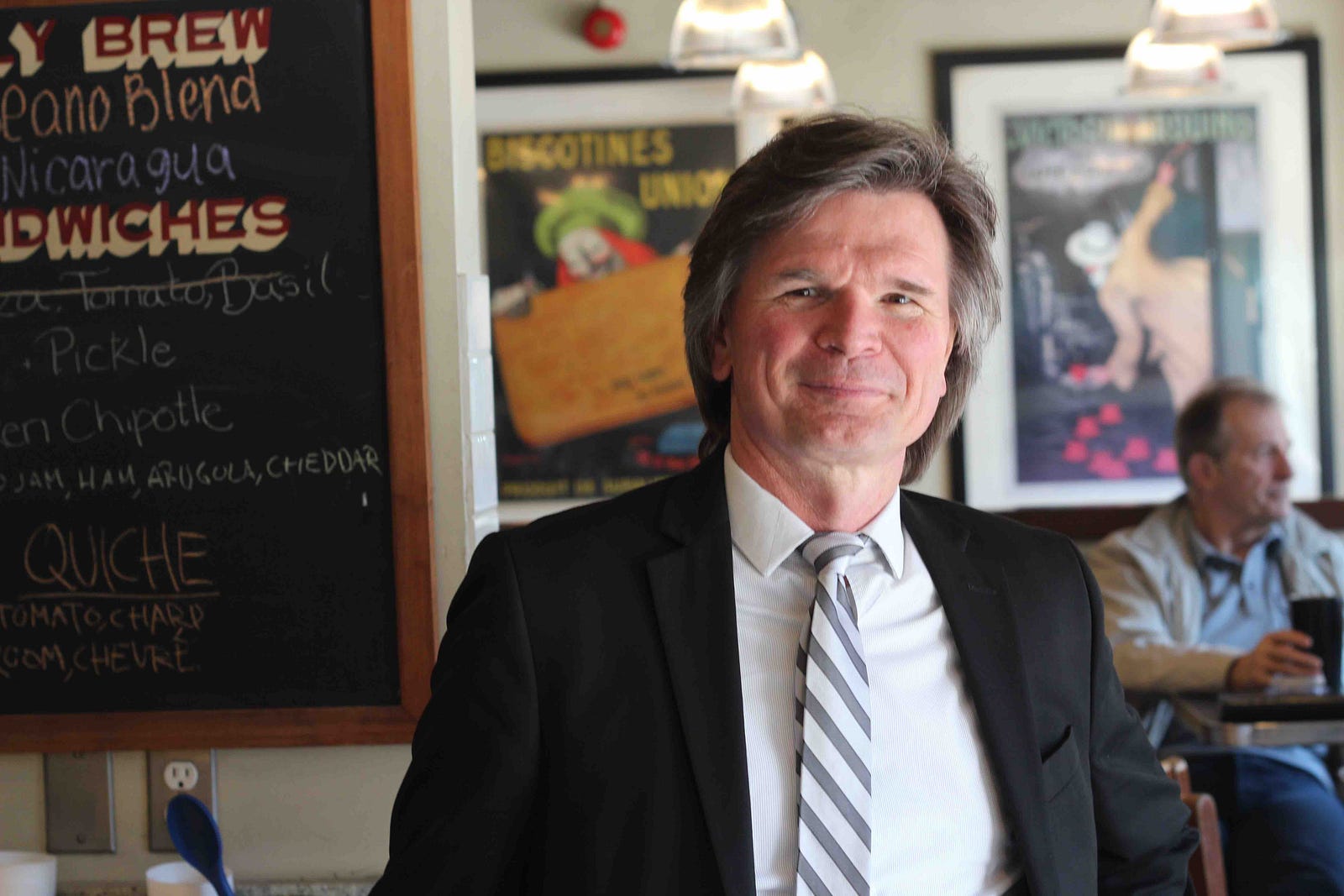
But as a middle-aged male, Stanley matches the profile of the confident cyclist who’s comfortable riding among cars (“I loved the interaction with vehicles,” he says of his former bike commute in Toronto). There’s a massive gender gap in urban cycling: only 25% of cyclists in the city’s 2016 bicycle and pedestrian count were female.
New cycling infrastructure is geared more toward people like González than Stanley.
“I’m a scaredy-cyclist,” says González. “I usually just ride on the sidewalk here [on 17th] because it’s crazy. I’d rather go super slow behind people than risk my life on the road. People speed like crazy and you have doors opening.”
“They could get rid of one lane of parking and give us a little.”
Local blogger and community activist Mike Morrison believes it’s a mistake to keep bikes on 15th Avenue instead of 17th.
“No one wants to be on 15th,” says Morrison, creator of Calgary by Bike. “Everyone wants to be on 17th. I think the businesses would greatly benefit from having cycle tracks on 17th, where people can say, ‘Oh hey, there’s a spot open on the Ship patio, let’s pull over.’ Or, ‘This store is having a clothing sale.’”
Back at Blanco Cantina, that’s the sort of behaviour Mitchell has been observing, thanks to the construction fences pushing people a little closer.
“It creates this funnel where they’re forced to check us out, where they maybe would have been bolting by or concerned about vehicles or noise or whatever,” she says. “You’re more likely to stop and have a look at a menu or read a sign when you’re walking than when you’re in a car.”
Jeremy Klaszus is editor-in-chief of The Sprawl.
For more about the future of 17 Ave SW, check out the latest episode of Sprawlcast (subscribe on iTunes).
We rely on crowdfunding to do in-depth Calgary journalism like this. Please support the Sprawl so we can keep it up!
Support independent Calgary journalism!
Sign Me Up!The Sprawl connects Calgarians with their city through in-depth, curiosity-driven journalism. But we can't do it alone. If you value our work, support The Sprawl so we can keep digging into municipal issues in Calgary!



